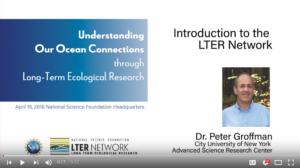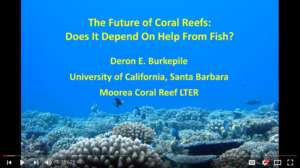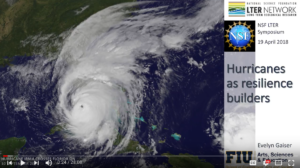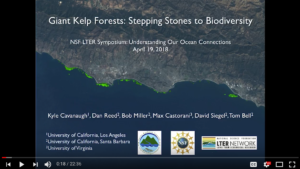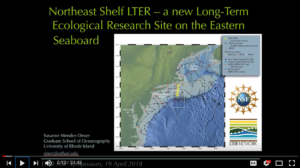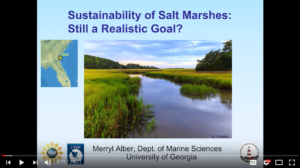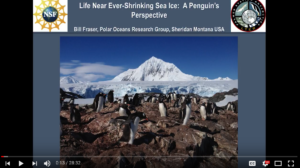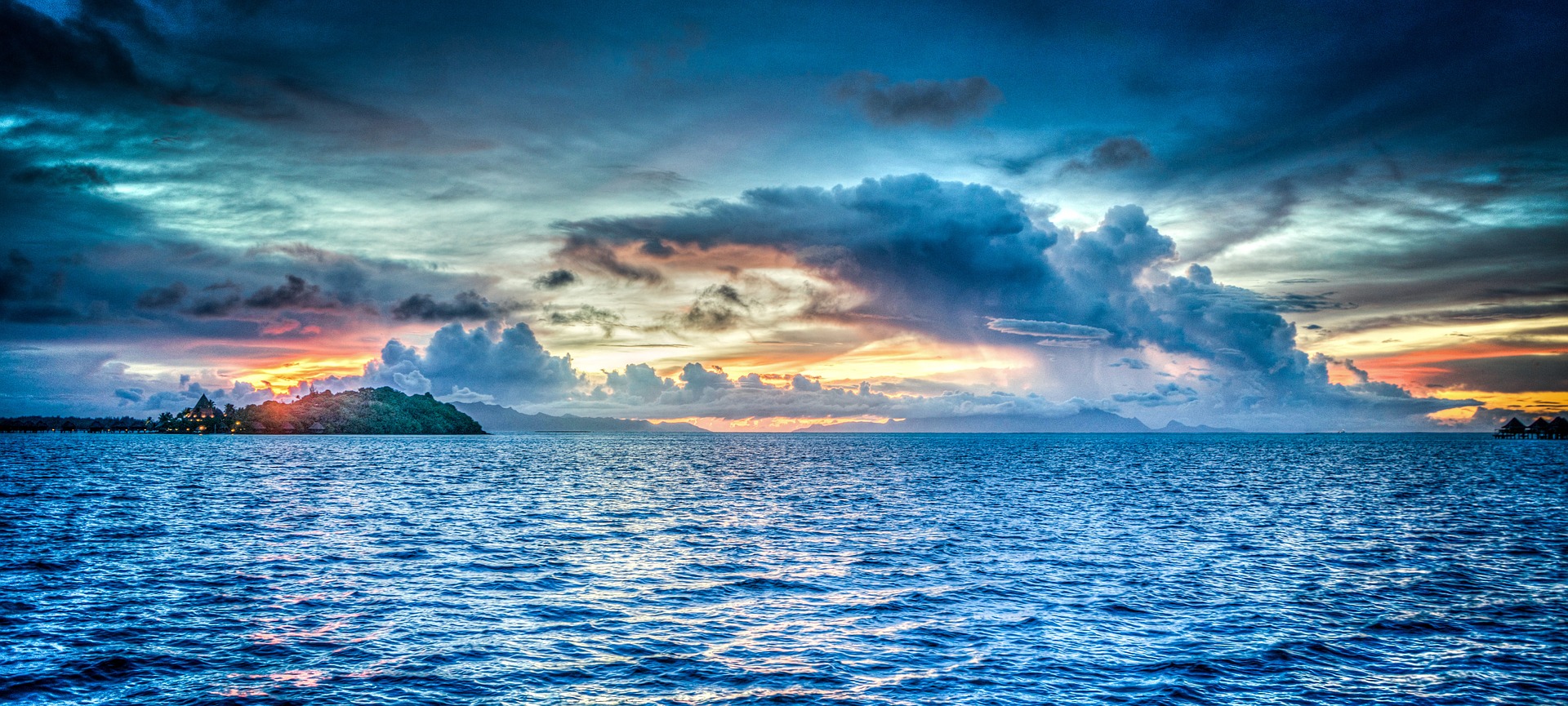
The connections between humans and oceans run deep. Kelp forests, plankton, estuaries, and coral reefs support robust and diverse food webs, feeding both body and spirit. The destructive effects of big storms are tempered by marshes and mangroves—sometimes to their benefit and sometimes their detriment. Currents, migrations, climate, and nutrients connect ecosystems and the communities of plants, animals and microbes that comprise them. Researchers from Long-Term Ecological Research sites have probed these connections at scales from local to global and presented their findings in a symposium at the National Science Foundation in April 2018.
At the symposium, “Understanding our Ocean Connections Through Long-Term Ecological Research,” scientists from six coastal and marine LTER sites presented their latest research on everything from the impact of melting sea ice on penguins, to the role that hurricanes play in building ecological resilience. Presentations drew on examples from coral reefs, kelp forests, coastal salt marshes, temperate shelves, and wetlands to describe observed dynamics, ongoing changes, and a view to where these systems may be headed in the future.
Each year, the National Science Foundation Long-Term Ecological Research (LTER) Network presents an overview of the rich and varied research taking place at its 28 sites. Nearly 100 guests from various academic, research, government, and NGO institutions attended the half-day event, which was held at the National Science Foundation headquarters in in Alexandria, Virginia.
Each of the seven LTER Symposium presentations is now available on the LTER YouTube channel, via the links below, or find the full playlist here.
An Introduction to the LTER Network
Peter Groffman, City University of New York, Chair of LTER Science Council
The 2018 NSF-LTER Symposium theme was ‘Understanding Our Ocean Connections through Long Term Ecological Research.’ In this first presentation, Dr. Peter Groffman provides an introduction to the structure and history of the LTER network and its contribution to long term ecological research, with an emphasis on coastal and marine systems.
The Future of Coral Reefs: Does It Depend on Help from Fish?
Deron Burkepile, UC Santa Barbara, NSF Mo’orea Coral Reef LTER Site
Coral reefs are a hub of marine biodiversity. They provide food, recreation and shoreline protection to some 1 billion people. But reefs around the globe have seen 50 to 90 percent declines in coral abundance, and forecasts of reef health have been dire. Long-term research by scientists at the NSF Mo’orea Coral Reef LTER Site shows that reducing nutrient pollution and fish over-harvesting can help reefs resist and recover from the impacts of large-scale disturbances such as coral bleaching – and may help corals survive in a warming world.
Hurricanes as Resilience-Builders
Evelyn Gaiser, Florida International University, NSF Florida Coastal Everglades LTER Site
Ecosystem health – like human health – is the result of a combination of chronic and short-term stresses. When will these stresses result in a stronger system, and when will they launch a downward spiral? Researchers at the NSF Florida Coastal Everglades LTER site combine field work, large-scale experiments, and ecological models to offer new answers. For example, they’re providing evidence that storms such as hurricanes can buffer the effects of increasing sea level rise. It all comes down to resilience, these scientists say.
Giant Kelp Forests: Stepping Stones to Biodiversity
Kyle Cavanaugh, UC Los Angeles, NSF Santa Barbara Coastal LTER Site
Giant kelp is an example of a foundation species — one that physically modifies its environment and provides food and habitat for an entire ecological community. In contrast to long-lived foundation species such as forests, coral reefs and mangroves, giant kelp has a short life span, leading to fluctuations in its abundance and its genetics. Long-term research at the NSF Santa Barbara Coastal LTER Site is yielding new insights into how giant kelp populations vary and what impact they have coastal ecosystems.
Northeast Shelf LTER – A new Long-Term Ecological Research Site on the Eastern Seaboard
Susanne Menden-Deuer, University of Rhode Island, NSF Northeast U.S. Shelf LTER Site
The Northeast U.S. Shelf generates millions of dollars in revenue from fishing, energy development and shipping. It’s also used for waste disposal, recreation and conservation. And almost 30 percent of the U.S. population lives along its shores. Researchers at the NSF Northeast U.S. Shelf LTER Site are melding historical records with long-term observations of the oceans, then combining them with mathematical models and large-scale experiments. The findings will ultimately inform the management of this productive ecosystem, from its phytoplankton and zooplankton to its commercially valuable fish.
Sustainability of Salt Marshes: Still a Realistic Goal?
Merryl Alber, University of Georgia, NSF Georgia Coastal Ecosystems LTER Site
Intertidal marshes – lands between the tides – are ever-changing ecosystems. They’ve kept pace with changes in sea level over millennia, but today’s rate of sea-level rise and increasingly common droughts and storms pose new challenges. An influx of saltwater, for example, has the potential to change how coastal marshes function – and may even threaten their existence. Experiments at the NSF Georgia Coastal Ecosystems LTER Site, and comparisons with other NSF long-term research sites, are providing insights into the environmental and human factors that increase or decrease the effects of flooding from severe storms and sea-level rise. Can salt marshes stay resilient in the face of such changes?
Life on Ever-Shrinking Sea Ice: A Penguin’s Perspective
Bill Fraser, Polar Oceans Research Group, Oregon State University, NSF Palmer Station LTER Site
The Western Antarctic Peninsula is among the most rapidly warming regions on Earth. Mid-winter temperatures have increased, on average, by more than six degrees Celsius over the last six decades, resulting in melting of sea ice and changes in the timing of seasonal events such as when the ice first freezes for the winter season and when it thaws in the Antarctic spring. Species such as Adélie, Chinstrap and Gentoo penguins use sea ice differently. Their responses to the warming of Antarctica are leading to new insights into changing food webs in one of the planet’s most distant places.

